Those beautiful and colorful dwarf shrimp are still on the increase in popularity. Especially in planted tanks and aquascapes, these small aufwuchs eaters are welcome guests, since they take care of all sorts of biofilms, including nascent algae films. Fundamental information on aquarium shrimp keeping can be looked up in this article. Not every shrimp species is suitable for a planted aquarium, though.
Dwarf shrimp in a planted tank?
Dwarf shrimp are a relatively heterogenous group. Among them there are species that are not suitable for a plant aquarium at all: shrimp from the Old Lakes of Sulawesi, for example, which are attractively colored but require very special water parameters, very clean water with as little nitrate (NO3) and phosphate (PO4) as possible, but most of all temperatures that are absolutely unsuitable for most aquarium plants. Sulawesi shrimp such as the Cardinal Shrimp (Caridina dennerli), the Harlequin Shrimp (Caridina woltereckae) and the Blue Leg Poso Shrimp (Caridina caerulea) are even more unsuitable for veritable aquascapes since you’d be way too restricted when it comes to fertilizing, and with water temperatures of roughly 30 °C, which they require, your choice of plants would be very limited.
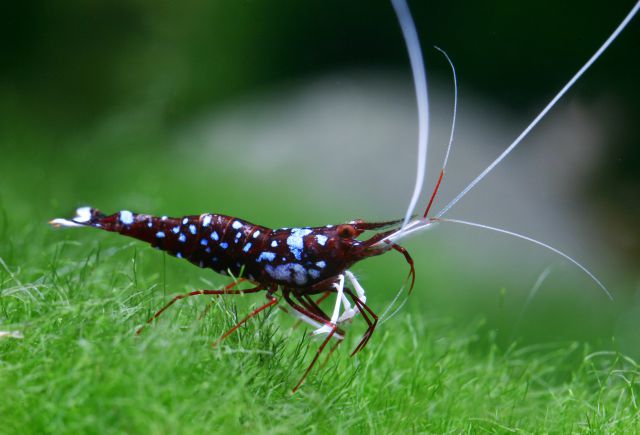
Caridina dennerli - Copyright by Chris Lukhaup
Breeds such as Pinto Shrimp and Boa Shrimp may look spectacular, but they are not necessarily suitable for classic planted aquariums and aquascapes either. This is, on the one hand, due to the fact that these strains still need to undergo heavy selective breeding until their patterns are fully established (which, for practical reasons, is an almost impossible task in a well-planted tank), on the other hand, these shrimp may react with molting problems to nitrate levels as low as 5-10 mg/l.
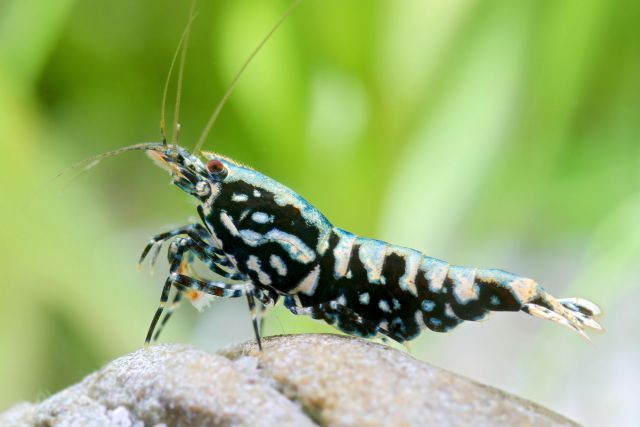
Blue Boa, a Caridina hybrid - Copyright by Chris Lukhaup
Nitrate has been observed to inhibit the iodine uptake in these high-bred shrimp especially strongly. Since iodine is absolutely crucial for producing the molting hormone ecdysone, nitrate in an aquarium with high-bred shrimp has a particularly harmful effect. However, many of the more challenging aquatic plants need a slightly higher nitrate level, so their requirements clash with those of high-bred Caridina shrimp.
The black-translucent, black-blue or red-translucent striped Tiger Shrimp (Caridina mariae) and the red-white and black-white standard Bee Shrimp (Caridina logemanni), also called Red Bee or Black Bee Shrimp, are not quite as sensitive and can stomach nitrate values between 10 and 25 mg/l. These beautiful shrimp are a perfect fit for green planted aquariums. They originate from habitats with rather soft to very soft water, and they also like their aquarium water with a low carbonate hardness, which is perfect for many aquarium plants.
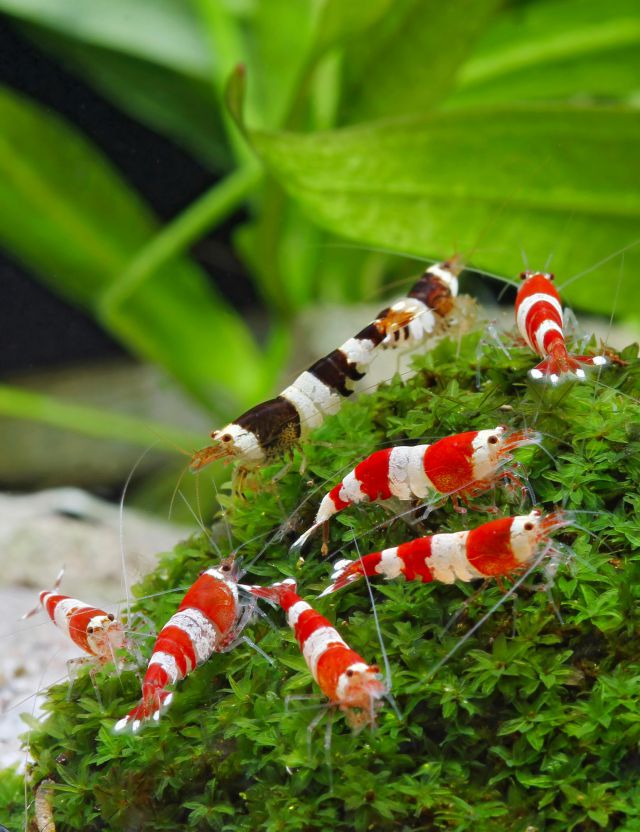
Red and Black Bee Shrimp of the species Caridina logemanni - Copyright by Chris Lukhaup
Besides Bee Shrimp and Tiger Shrimp you’ll find many pretty and quite robust color variants of the genus Neocaridina in many planted tanks. In the hobby, the species Neocaridina davidi and Neocaridina palmata have become firmly established. In contrast to Bee Shrimp and Tiger Shrimp, those Neocaridina don't exclusively originate from clear, clean streams, but also from stagnant waters like bogs and lakes. They can therefore deal with significantly higher nitrate values (up to 40 mg/l) and are much less sensitive when it comes to harder water: anything is possible from soft-ish to hard.
Neocaridina are available in a great variety of colorations, from red and orange over green to black, chocolate brown, light and dark blue and yellow, anything is there. Many shrimp, mostly females, have a lighter-colored backline, and there is also a Rili variant of almost all these colors. Rili shrimp are characterized by transparent areas in the middle of the body with an otherwise opaque color. Please keep in mind when cross-breeding different Neocaridina color variants that the offspring may be wild colored, meaning mostly transparent and dark patterned. If you want to keep the colors pure, you shouldn’t go for the candy-store approach when stocking your tank with shrimp even though it looks really good at first.
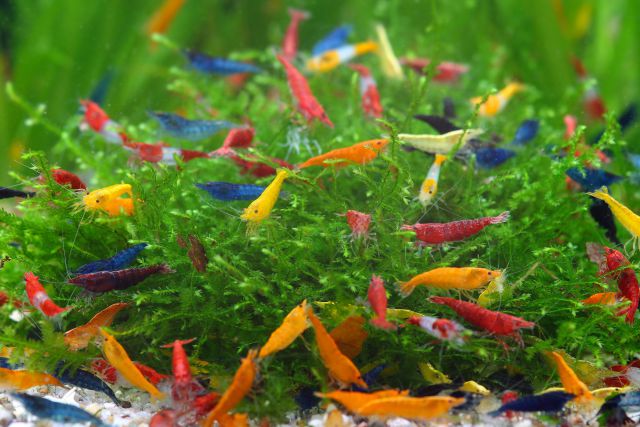
Colourful mix of Neocaridina davidi - Copyright by Chris Lukhaup
In aquascapes and planted tanks, active soil substrates such as ADA Aquasoil Amazonia are used since they soften the water and make it more suitable for aquatic plants thanks to their ion-exchanging abilities. Fundamentally this principle is a great idea for planted tanks with shrimp as well. However, if you use regular tap water for your weekly water changes, as you would probably do with a shrimpless tank, you may cause quite severe fluctuations in the water parameters. Where aquatic plants don’t give a hoot about this, shrimp resent it very much and may react with molting issues. It is therefore advisable to work with adapted water right from the beginning to avoid fluctuations. If your tap water’s parameters are too different from those of your aquarium, you should resort to RO or demineralized water and adjust the corresponding parameters using a Bee-Shrimp-friendly remineralizing salt. These remineralizing salts should of course always be chosen according to the specific shrimp you are keeping. They are extremely user-friendly: Just add to the fresh changing water in a container outside the aquarium and stir a bit.
Soils designed specifically for shrimp such as Borneo Wild Shrimp Soil are not pre-fertilized. These aquaria can be stocked with shrimp sooner. They function in the aquarium exactly like the frequently-used ADA Aquasoil Amazonia, however, so-called planting soils often emit a lot of ammonium (NH4) at the beginning of their useful life, and shrimp should only be introduced into the tank when the ammonium level is back to normal, at 0,25 mg/l or below.
Excellent algivores
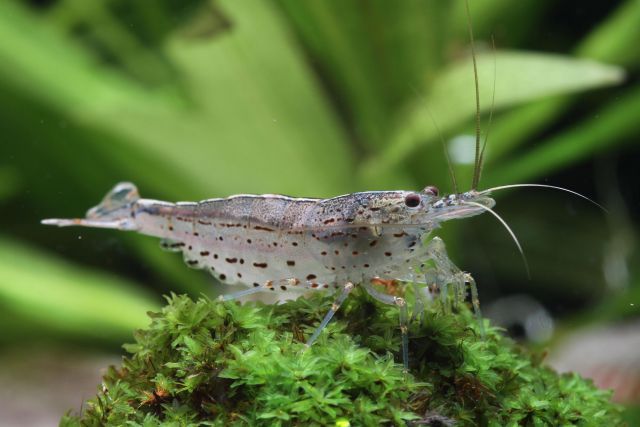
The Amano Shrimp, Caridina multidentata - Copyright by Chris Lukhaup
Apart from the colorful dwarf shrimp, there’s an all-purpose shrimpy weapon against algae: the Amano Shrimp (Caridina multidentata), previously known as Yamato Shrimp. It was made popular by Takashi Amano, and has even been given a new trivial name thanks to that. It is not colorful but definitely unique in its own way. Amano very much liked to use these relatively large and very easy-to-keep shrimp found in nature in Japan in his Nature Aquariums since they are excellent algivores. In contrast to the smaller types of dwarf shrimp they don’t just eat nascent algae films but up to and including fully-grown filamentous green algae. However, since Caridina multidentata grow pretty large with up to 6 cm and love a good swim, they are not suitable for nano aquariums and small cubes. The Amano Shrimp at least needs a tank with a front length of 60 cm or more. If those little clowns have enough space, they more than make up for the lack of color through their extremely interesting behavior.